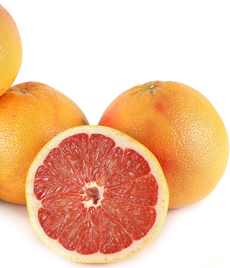TIP OF THE DAY: Red Grapefruit, The Best Winter Fruit
|
Grapefruit is a winter fruit, and we’re glad to have it. America is the world’s largest consumer of grapefruit, with large commercial groves in Arizona, California, Florida and Texas. But the grapefruit’s ancestor, the pummelo (also pomelo, pomello and other spellings), comes from far away. It’s native to Malaysia and Indonesia. In 1693, pummelo seeds were brought from the East Indies to the West Indies—Barbados—by an English ship commander, one Captain Shaddock. The grapefruit may have been a horticultural accident or a deliberate hybridization between the larger pummelo and the smaller sweet orange. The original grapefruit was about the size of the orange. Its name evolved in English to a descriptive one: The fruit grows on trees in grape-like clusters. The fruit was pretty but very sour and the thick took time to peel. For a long time, it was grown only as an ornamental tree. The grapefruit arrived in the U.S. in 1823, but it was not immediately popular for eating. The tart fruits had numerous tiny seeds and required a generous sprinkling of sugar. Growers learned how to breed selective fruits that were sweeter, and in 1870, the first grapefruit nursery was established in Florida. In 1885, the first shipment of grapefruits arrived in New York and Philadelphia, generated interest and helped to create the commercial grapefruit industry. Here’s a longer history of grapefruit. Most grapefruit grown is white grapefruit. But hopefully that will change: Red grapefruit (not pink) is where it’s at. The first grapefruits were white. Pink grapefruit, a mutation, was first discovered in 1906 in the groves of the Atwood Grapefruit Company in Manatee County, Florida. |
 [1] Sweet Scarlett red grapefruits (photo © Wonderful Fruit).
[2] The yellow rinds often have a pink blush (photo of Star Ruby grapefruits Sweet Scarlett red grapefruits. Photo courtesy Wonderful Fruit © Specialty Produce). |
|
|
One day, a grove foreman peeled a grapefruit with the intention of eating it, and discovered that the fruit inside was pink! A local nurseryman was able to propagate the pink fruit, and it met with big success: In addition to a more pleasing color, the flesh tended to be sweeter. Another mutation gave us red grapefruit, which was originally discovered growing on a pink grapefruit tree in Texas. It was patented as Ruby Red grapefruit in 1929. Red grapefruit is known in agriculture as a “limb sport,” a mutation of one limb (branch) that has different fruit characteristics than the rest of the tree. A hit from the start, sweeter with alluring rosy red flesh, Ruby Reds are marketed under different names: Flame, Rio Red, Rio Star, Ruby-Sweet, Star Ruby, Sweet Scarletts, TexaSweet and others. While consumers call these different red grapefruits “varieties,” botanically it’s more accurate to call them different “selections” because they are all derived from one another as descendants of the original Ruby Reds. Each has different small attributes, tailored to succeed in different climates and soils. Otherwise stated, all of the different deep red grapefruits grown around the world—Rio Red in Texas, Star Ruby in South Africa, Flame in Florida, etc.—are not botanically different, but have been adapted to the the climate and soil in each region. Different selections also have different shades of flesh. For example, Florida’s Ruby Reds are deep pink, while Flame grapefruits have deep red flesh. |
||
 Simple yet elegant: Rio Star grapefruit sections in an avocado half. Here’s the easy recipe. Photo courtesy TexaSweet. |
WHAT MAKES THE FLESH RED? Red and pink grapefruits contain lycopene, a phytochemical (antioxidant) found in tomatoes and some other red fruits and vegetables such as papaya, red carrots and watermelon. Red grapefruits have a greater concentration than pink grapefruits. Why are red grapefruits sweeter? It’s all in the weather. Sweet Scarletts, for example, are grown in the Rio Grande Valley of Texas, where hot days, cool nights and the unique terroir† merge to create the ideal grapefruit. Most red grapefruits are grown in Texas, since the The Texas climate produces the sweetest red grapefruits. Different regions are ready to harvest at different times; but in general, red grapefruit is available from October through March. We have been enjoying a box of Sweet Scarletts, and couldn’t be happier. They’re so sweet and lush, who needs ice cream? |
|
|
If you aren’t already a grapefruit lover, head to the store and bring some home. They’re sweet, juicy, and low in calories* (42 calories per 3.5 ounces of flesh). It’s one of our favorite great-tasting and great-for-you foods. HOW MANY DIFFERENT WAYS CAN YOU SERVE RED GRAPEFRUIT? Here are nine pages of red grapefruit recipes, from cocktails and appetizers through main courses, sides and desserts. †Terroir, a French word pronounced tur-WAH, refers to the unique combination of geographic location, climate and microclimate, soil and temperature that creates the individual personality of an agricultural product. As in the growing of grapes for wine or beans for coffee, terroir dramatically affects the flavor profiles of the product.
|
||



